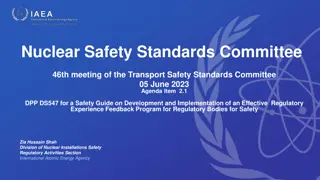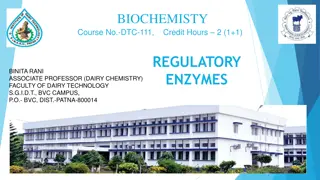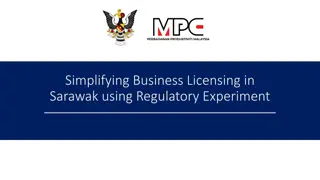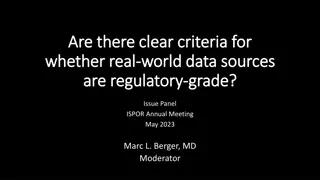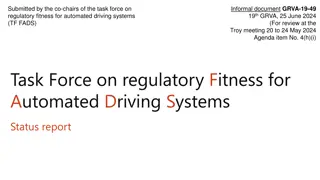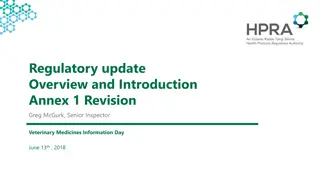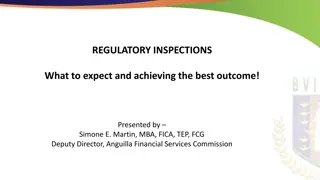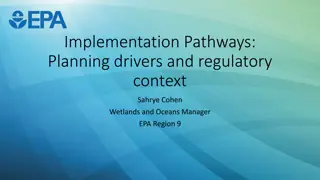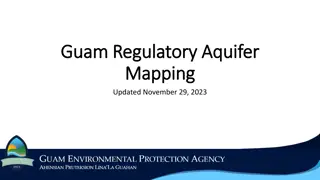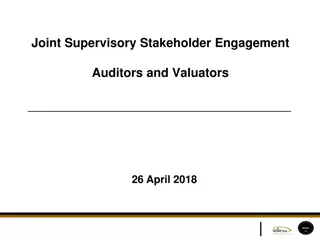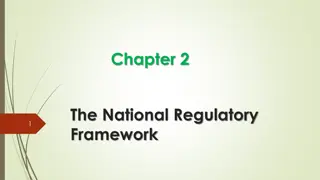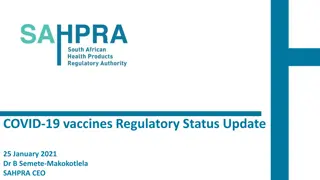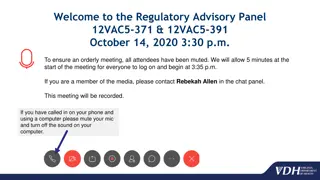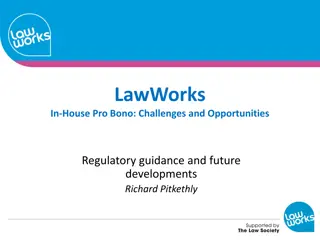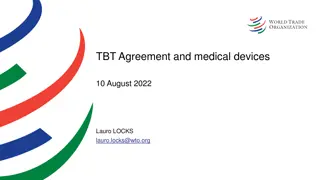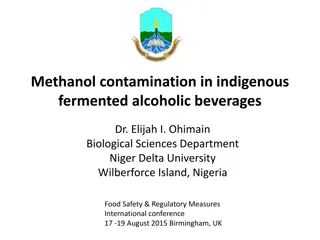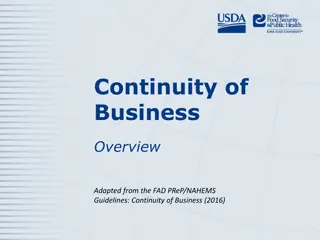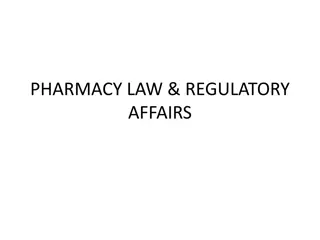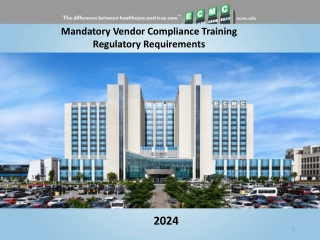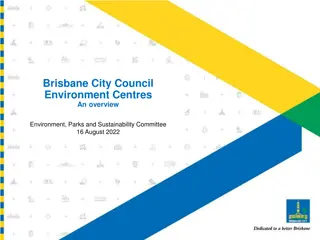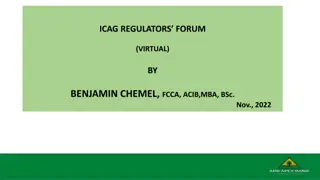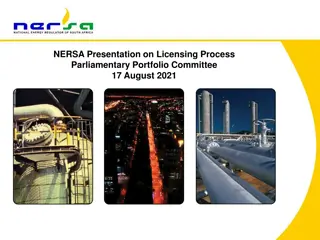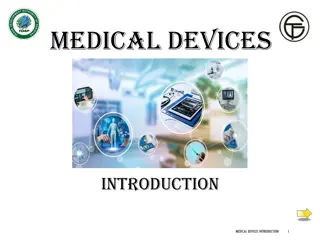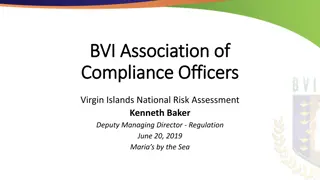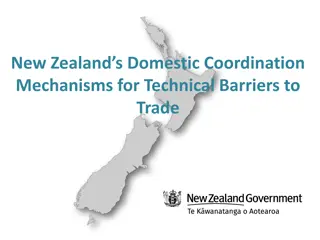Understanding the Regulatory Environment: A Comprehensive Overview
This session delves into the regulatory landscape focusing on the objectives, types, and origins of regulations in the financial sector, particularly in Nigeria. It discusses the essential role of regulation in promoting compliance, protecting stakeholders, and maintaining operational integrity within the industry. Participants will gain insights into the global standards for financial regulation, factors influencing regulatory frameworks, and the significance of regulatory architecture in ensuring effective oversight. Ultimately, the session aims to equip individuals for the Compliance Institute Examination by providing a solid foundation in regulatory principles.
Download Presentation

Please find below an Image/Link to download the presentation.
The content on the website is provided AS IS for your information and personal use only. It may not be sold, licensed, or shared on other websites without obtaining consent from the author. Download presentation by click this link. If you encounter any issues during the download, it is possible that the publisher has removed the file from their server.
E N D
Presentation Transcript
UNDERSTANDING THE REGULATORY ENVIRONMENT 1.1 Presented By: Isioma Gogo-Anazodo
Content 1. Aims and Objectives 2. What is Regulation? 3. Types of Regulation 4. Objectives of Regulation 5. Origin of Bank Regulation/Supervision in Nigeria 6. The Global Standards for Financial Regulation 7. Factors Influencing Regulation 8. The Regulatory Architecture 9. Conclusion
Aims and Objectives The objectives of this session are: To acquaint participants with Regulation as it affects the compliance function. To discuss the history of regulation in the Nigerian Banking system. To create a base for preparation for the Compliance Institute Examination.
What is Regulation? Regulation is a set of specific standard control system put in place by a supervisory body to promote compliance with laid down process, provisions of the law and recommended best practices; for the ultimate benefit of all stakeholders. Regulation can also be defined as: A legislation, rule, directive, act, circular, statute, edict, ordinance, pronouncement, mandate, injunction, procedure, requirement, guidelines or prescriptions made and maintained by an authority.
Types of Regulation There are two (2) major types of regulation: Primary Regulation Primary Regulations are standards of behaviours put in place by the arm of the state charged with law making. These include all laws, decrees, statute or any other norm that requires the approval of parliament or the Head of state. Secondary Regulation Secondary Regulations are standards of behaviours or the controls put in place by institutions empowered by the law to do so by the enactment of a primary regulation which also established them. These institutions are known as Regulators. Secondary regulations include circulars, directives, rules, guidelines and norms enacted directly by agencies of government or self-regulated organizations (SROs).
Objectives of Regulation The following are the objectives of regulation: The ultimate goal of regulation is to ensure a smooth, fair and honest operation within the sector it seeks to regulate. Regulation is put in place for the protection of stakeholders, which include: the consumers, investors and Government. Regulation is adopted to instill discipline and confidence in the system it seek to regulate. To make financial institutions operate within boundaries. Regulation is put in place to avoid the ripple effect of failures and recklessness due to non-regulation. Regulation is put in place to safeguard the public against Negative Externalities resulting from unregulated actions or inactions of Operators. 1. 2. 3. 4. 5. 6.
Origin of Bank Regulation/Supervision in Nigeria The origin of regulation in the banking industry in Nigeria dates back to the early 1950s following the tragic failures suffered by the largely unregulated indigenous banks a phenomenon which caused untold hardship for many banks. The Central Bank of Nigeria Act 1958 signaled the commencement of a true regime of indigenous regulation of banking in Nigeria after the Banking Ordinance of 1952 which was the first to specify among others a minimum paid-up capital for Banking business. To address the issue of multiple regulations in Nigeria banking Sector, the CBN in April 1994 undertook to facilitate a formal framework for the co-ordination of regulatory and supervisory activities in the Nigerian financial sector by establishing the Financial Services Coordinating Committee (FSCC) to address more effectively, through consultations and regular inter-agency meetings, issues of common concern to regulatory and supervisory bodies.
The Global Standards for Financial Regulation Some of these standard setting bodies are products of the efforts of some leading financial Institutions in the world, others are products of governments of the leading countries in the world who had come together to put these institutions in place for the global interest. Some of these are: Basel Committee The International Association of Insurance Supervisors (IAIS) The International Organization of Securities Commission (IOSCO)
Factors Influencing Regulation Regulation is dynamic and a derivative of the following: Power and Politics Market Dynamics Environmental Factors Technology and Innovation Globalization Socio-cultural Factors Public Opinion The Media Consumer Rights Labor and Employment Crime and Illegal Activities
Types of Regulators, by areas of specialization Regulators in the Financial Sector are empowered for the regulation of specific subsectors of the financial sector, these are: I. Banking Business Regulators II. Capital market Regulators III. Insurance Regulators IV. Consolidated Regulators body (such as the Financial Services Regulation Coordinating Committee - (FSRCC).
Conclusion The arrangement of the constituents of the regulatory architecture results to a pyramid of numbers, with the regulators at the apex of this pyramid and the operators and their employees at the base. For a regulation to achieve its objective, it is important that those at the apex of the pyramid anticipate the likely response of operators and steer them towards common good
Practice Question 1 What is the objective of government in the regulation of financial institutions in the country? A. To generate revenue from the financial institutions B. Strengthen the relationship between the government and the institutions. C. Ensure financial institutions treat their staff fairly D. To protect the general public and provide accountability.
Practice Question 2 What does the FSCC stand for? A. Financial Services Coordinating Committee B. Financial Services Cooperation Committee C. Financial Service Center Cooperative D. Financial Solutions Consumer Center
Practice Question 3 Regulation is dynamic and a derivative of the following EXCEPT: A. Technology and Innovation B. Power and Politics C. Market Gimmicks D. Socio-cultural factors
Practice Question 4 Regulation is dynamic and a derivative of the following EXCEPT: A. Technology and Innovation B. Power and Politics C. Market Gimmicks D. Socio-cultural factors
Practice Question 5 Primary Regulations are standards of behaviours put in place by the arm of the state charged with law making and they include A. Laws, decrees and statutes B. Laws, rules and regulations C. Laws, circulars and guidelines D. Laws, decrees and regulations
END OF MODULE 1.1 Presented By: Isioma Gogo-Anazodo Email: blessisioma@gmail.com Phone: 07064189103
Regulation in Practice 1.2 Presented By: Isioma Gogo-Anazodo
Approaches and Models of Regulations There are five (5) key components of a good regulation. i. Transparency: It should be simple, open and user friendly ii. Accountability: To the state, consumers, operators and the public iii. Targeting: It should focus on the problem and minimise the side effects. iv. Consistency: It should be predictable. People should know where they stand. v. Proportionality: The remedy should fit the risk. Only regulate when there is need.
Approaches and Models of Regulations (Contd.) Regulations take many forms. Notable among the various approaches and models are: Self-Regulation Quasi Regulation Co-Regulation Explicit Government Regulation (Black letter Law) Alternative Instruments
Approaches and Models of Regulations (Contd.) Self-Regulation Self-regulations is generally characterised by industry formulating rules and codes of conduct, with industry solely responsible for enforcement. In most instances, self- regulation should be the first option considered. Self-regulation should be considered where: There is no strong public interest concern, in particular, no major public health and concern. The problem is a low-risk event, of low impact or significance The problem can be fixed by the market itself. For example, there may be an incentive for individuals and groups to develop and comply with self-regulatory arrangements.
Approaches and Models of Regulations (Contd.) The likelihood of self-regulatory industry schemes being successful is increased if there is: Adequate achievable coverage of the industry concerned A viable industry association A cohesive industry with likeminded or motivated participants committed to achieving the goals Evidence that voluntary participants can work, effective sanctions and incentives can be applied, with low scope for the benefits being shared by non-participants and A cost advantage from tailor-made solution and less formal mechanism, such as access to quick complaints handling and a dress mechanism, or the need to make regulatory adjustments quickly to meet developing market circumstances. However, care must be taken to ensure any proposed self-regulatory approaches are not anti- competitive, for example, by restricting any new entry of market participants or discouraging the adoption of new technology.
Approaches and Models of Regulations (Contd.) Quasi Regulation Quasi-Regulation includes a wide range of rules or arrangements where governments influence business to comply, but which do not form part of explicit government regulation. Some examples of quasi-regulation include industry codes of practice developed with government involvement, guidance notes, industry-government agreement and accreditation schemes. Quasi-Regulation should be considered where: There is a public interest in some government involvement in addressing a community concern and the issue is unlikely to be addressed by self-regulation. There is a need for an urgent, interim response to a problem in the short term, while the long-term regulatory solution is being developed. Government is not convinced of the need to develop or mandate a code for the whole industry. There are cost advantages, from flexible, tailor-made solution and less formal mechanism. There are advantages in the government engaging in a collaborative approach with the industry having substantial ownership of the scheme
Approaches and Models of Regulations (Contd.) For this to be successful there needs to be: A specific industry solution rather than regulation of general application A cohesive industry with likeminded participant, motivated to achieve the goals A viable industry associated with the resources necessary to develop and/or enforce the scheme Effective sanctions or incentives to achieve the required level of compliance, with low scope for benefits being shared by non-participants Effective external pressure from the industry itself (survival factors/or threat of consumer or government action) As in the case of self-regulation, proposed approaches should not restrict competition
Approaches and Models of Regulations (Contd.) Co-Regulation Co-Regulation typically refers to the solution where the industry develops and administers its own arrangements, but government provides legislative backing to enable the arrangements to be enforced. This is known as underpinning of codes, standards and so on. Sometimes, legislation sets out mandatory government standard but provides that compliance with the industry code can be deemed to comply with these standards. Legislation may also provide for government imposed arrangements in the event that industry does not meet its own arrangements.
Approaches and Models of Regulations (Contd.) Explicit Government Regulation (Black letter Law) Explicit Government Regulation, sometimes referred to as Black letter law comprises both primary and subordinate legislation. It is the most commonly used form of regulation. While it can have a number of advantages when compared with the other forms of regulation, there can also be several important disadvantages associated with its use. The main advantages relate to it s certainty and effectiveness because of the availability of legal sanctions. The possible draw backs include that it may be standardised and inflexible, take significant time to make or amend, not be suitable for influencing the quality of complex service, be perceived to be difficult to understand and go with, have higher government budgetary costs and provide poor access for these without the means to pursue their legal rights.
Approaches and Models of Regulations (Contd.) Explicit government regulation should be considered where: The problem is high risk, of high impact or significance. For example a major public health and safety issue The community requires the certainty provided by legal sanctions Universal application is required or at least where the coverage of an entire industry sector or more than one industry sector is judged as necessary. There is a systemic compliance problem with a history of intractable disputes and repeated or flagrant breaches of fair trading principles and no possibility of effective sanction being applied. Existing industry bodies lack adequate coverage of industry participation, are inadequately resourced or do not have a strong regulatory commitment.
Approaches and Models of Regulations (Contd.) Alternative Instruments Within each form of regulation, a number of alternative instruments can often be used. Alternative instruments may include. No specific action (that is rely on the market in conjunction with existing general liability law) Information and Education campaigns (including product labelling or media campaigns Market-based instruments (including taxes, subsidies, tradable permits, performance bonds, tradable property rights) Pre-market assessment schemes (such as listing, certification and licensing) Pots-market exclusion measures (ash as bans, recalls, license revocation) Service charters Standards (including voluntary and regulatory, performance-based or prescription Other mechanisms, such as public information registers, mandatory audits and quality assurance schemes.
The Scopes of Regulation The sources of regulation include both domestic/national laws (laws that apply to activities within the jurisdiction of a sovereign nation) and international laws (agreements between sovereign nations). In general, law falls into 2 basic categories: Public law and Private law. Public Law addresses the relationship between the government and individuals/entities. Example, Law that gives the government the power to imprison an individual for money laundering or terrorist financing. Private Law addresses the relationship between private individuals/firms and other individuals/firms. Example, Law that allows customers to sue a bank for unauthorised withdrawal.
The Scopes of Regulation (Contd.) With regard to the regulation of banks, the primary, although not exclusive, focus is on public law. The law that gives the government the power to regulate banks and their activities. There is also some other standards of law that are more discretionary in nature. These are often referred to as soft laws. They are often derived from efforts of specialised groups to coordinate or improve the law either domestically or internationally. While such standards are not binding in a formal sense unless enacted into law by a sovereign nation, they can serve as a powerful tool in the development of formal regulation. A good example of this is the 40 Recommendation in AML/CFT by the Financial Action Task Force (FATF)
International Legislation and Best Practices Some of the common international legislation and best practices within the Financial Industry are: Basel Committee on Bank Supervision (BCBS). Often called the Basel Committee or the Bureau for International Settlement (BIS), the BCBS, has a profound impact on the regulation of bank s capital. It also plays an important role in developing standards and best practices on other technical issues in bank regulation as well as laying down the principles that govern international cooperation between bank supervisors. International Organisation of Securities Commission (IOSCO). IOSCO was created to promote high standards of regulation, to facilitate exchange of information, to establish standards for international securities transactions and to promote enforcement of standards International Association of Insurance Supervision (IAIS) The aim of IAIS is to promote cooperation among supervisors, set standards, provide training and coordinate work with regulators from other financial sectors.
International Legislation and Best Practices The Joint Forum The Joint Forum was established in 1996 under the auspices of the Basel Committee, IOSCO and IAIS. The Joint Forum facilitates information exchange in the 3 traditional financial sectors of banking, securities and insurance. International Association of Deposit Insurers (IADI) IADI seeks to promote international cooperation and facilitate communication among deposit insurers. Its members include representatives from deposit insurers from around the world.
International Legislation and Best Practices International Accounting Standards Board (IASB) IASB is dedicated to developing high-quality and enforceable global accounting standards. Organisation for Economic Cooperation and Development (OECD) Financial Action Task Force (FATF) FATF seeks to protect the global financial system from money laundering and terrorist financing. Committee on Payments and Settlement Systems (CPSS) The committee on Payment and Settlement Systems (CPSS) is a forum for central banks and therefore, its focus is on monetary and financial stability. The CPSS is hosted by the BIS and is a forum for the G10 central banks. The CPSS provides a means for central banks to coordinate their payment system responsibilities.
International Legislation and Best Practices International Monetary Fund (IMF) The IMF s purpose includes promoting world trade, stable exchange rates and orderly international payment systems. The IMF s main focus is on macroeconomic performance and financial sector policies. The IMF is often confused with the World Bank (The International Bank for Reconstruction and Development) While the World Bank s work is complimentary to the IMF s, the World Bank was created to promote long- term infrastructure development and poverty reduction. In contrast the IMF does not provide financing for particular sectors but rather assists its members in overcoming short-term balance of payment difficulties.
Regulators and their Powers Most regulators have the following functions and powers To advise and make recommendations to government To monitor and enforce compliance with regulations To provide advice and information to operators To collect, analyse and publish statistics To foster cooperative relationship between the public and the operators To promote and support education and trading To engage, promote and coordinate sharing of information To examine the compliance level of operators To sanction erring operators To issue licences and register operators Any other function conferred on them by law.
Practice Question 1 Basel Committee on Banking Supervision is also known as: A. BIS Committee B. Bank for International Settlements Committee C. Banking Regulation Committee D. Banking Settlements Regulatory Committee BIS Committee The Basel Committee on Banking Supervision (BCBS) is a committee of banking supervisory authorities established in 1974 by the governors of the central banks of G-10. It is also known as Bureau of International Settlement (BIS) Committee.
Practice Question 2 The five key components of a good regulation are: A. Accountability, Transparency, Targeting, Consistency and Proportionality. B. Transparency, Acceptability, Targeting, Consistency and Probity C. Accountability, Consistency, Transparency, Proportionality and Reliability D. Accuracy, Accountability, Targeting, Consistency and Proportionality
Practice Question 3 Select any two factors that will make self-regulatory Industry scheme successful. A. Adequate achievable coverage of the industry concerned B. A viable industry association C. Effective external pressure from the industry itself (survival factors/or threat of consumer or government action) D. Evidence that voluntary participants can work, effective sanctions and incentives can be applied, with low scope for the benefits being shared by non-participants
Practice Question 4 One of the objectives of the World Bank is to A. Promote world trade B. Create stable exchange rates C. Promote orderly international payment systems D. Promote long-term infrastructural development
Practice Question 5 The IMF was created to promote long-term infrastructure development and poverty reduction . True False
END OF MODULE 1.2 Presented By: Isioma Gogo-Anazodo Email: blessisioma@gmail.com Phone: 07064189103


